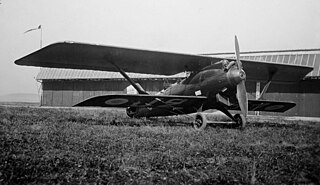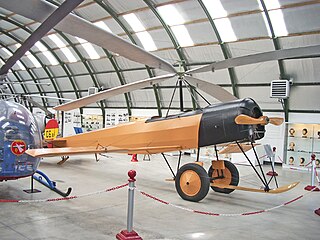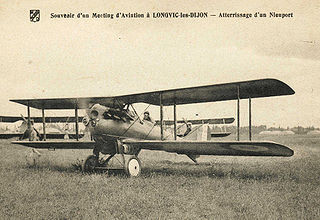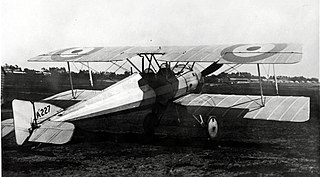
The Bristol F.2 Fighter is a British First World War two-seat biplane fighter and reconnaissance aircraft developed by Frank Barnwell at the Bristol Aeroplane Company. It is often simply called the Bristol Fighter, "Brisfit" or "Biff".

The Hispano-Suiza 8 was a water-cooled V8 SOHC aero engine introduced by Hispano-Suiza in 1914, and was the most commonly used liquid-cooled engine in the aircraft of the Entente Powers during the First World War. The original Hispano-Suiza 8A was rated at 140 hp (100 kW) and the later, larger displacement Hispano-Suiza 8F reached 330 hp (250 kW).

The Breguet 19 was a sesquiplane bomber and reconnaissance aircraft which was also used for long-distance flights and was designed by the French Breguet company and produced from 1924.

The Spanish Air Force (SAF) is the aerial branch of the Spanish Armed Forces.

The Hispano Aviación HA-1109 and HA-1112 are licence-built versions of the Messerschmitt Bf 109G-2 developed in Spain during and after World War II.

The Nieuport-Delage NiD 52 was a French fighter aircraft of the 1920s. A single-engined sesquiplane, it served with the Spanish Air Force, being operated by both sides of the Spanish Civil War.

The Cierva C.6 was the sixth autogyro designed by engineer Juan de la Cierva, and the first one to travel a "major" distance. Cierva, the engineer responsible for the invention of the autogyro, had spent all his funds on the research and creation of his first five prototypes. Therefore, in 1923, he turned to the Cuatro Vientos Aerodynamics Laboratory chief, Commander Emilio Herrera, who succeeded in persuading General Francisco Echagüe, the director of the Military Aviation Aeronautics Department, to take over the second stage in the research and development of Cierva's autogyros.

The Fiat CR.1 was an Italian biplane fighter aircraft of the 1920s. Of wood-and-fabric construction, it was designed by Celestino Rosatelli, from whom it gained the 'CR' designation. Its most distinctive feature was that the lower wings were longer than the upper ones.

The Nieuport-Delage NiD.29 was a French single-seat biplane fighter designed and built by Nieuport-Delage for the French Air Force.

The Lohner B.I was a military reconnaissance aircraft produced in Austria-Hungary during World War I. As Lohner strove to perfect the design, a variety of increasingly powerful engines were fitted, reflected in a range of military designations from B.II through to B.VI until the definitive B.VII was finally produced. This last version was also produced in an armed variant, designated the C.I.

The Morane-Saulnier BB was a military observation aircraft produced in France during World War I for use by Britain's Royal Flying Corps. It was a conventional single-bay biplane design with seating for the pilot and observer in tandem, open cockpits. The original order called for 150 aircraft powered by 110-hp Le Rhône 9J rotary engines, but shortages meant that most of the 94 aircraft eventually built were delivered with 80 hp Le Rhône 9C rotaries instead. A water-cooled Hispano-Suiza 8A engine was trialled as an alternative in the Type BH, but this remained experimental only. A production licence was sold to the Spanish company Compañía Española de Construcciones Aeronáuticas (CECA), which built twelve fitted with Hispano-Suiza engines in 1916.

The Loring R-III or R-3 was a 1920s Spanish two-seat sesquiplane reconnaissance and light attack aircraft designed by engineer Eduardo Barrón and built by Dr. Jorge Loring's company — Talleres Loring.

The Loring R-1 or R-I was a reconnaissance aircraft and light bomber produced in Spain in the late 1920s. It was the first design by Eduardo Barron for Jorge Loring's company — Talleres Loring, and the firm's first aircraft of its own design.

The González Gil-Pazó GP-1 was a single-engine, two-seat open cockpit training aircraft, built in Spain in the 1930s to compete for a government contract. Declared the winner, production was curtailed by the Spanish Civil War. Two cabin variants, the González Gil-Pazó GP-2 and GP-4, were also built.

Museum of Aeronautics and Astronautics, also known as Air Museum, is an aviation museum located near of Madrid, is situated at Cuatro Vientos Air Base, Spain. The objective of the museum is to acquire, conserve and display the aircraft, equipment and associated paraphernalia that constitute the historical heritage of the Spanish Air Force. It has an exterior exhibition and seven hangars.

The Hispano Suiza E-30, later renamed Hispano E-30, was designed in Spain in 1930 as a multi-purpose intermediate trainer. It was a single engine, parasol wing monoplane. About 25 served with the Spanish armed forces until 1945.

The Hispano-Suiza E-34, later renamed Hispano HS-34, was a Spanish single engine, tandem seat biplane, designed as a basic trainer. Twenty five were ordered by the Aeronáutica Naval, but only five had been completed when the Spanish Civil War intervened.

The Spanish Republican Armed Forces were initially formed by the following two branches of the military of the Second Spanish Republic:

Talleres Loring was a Spanish aeronautical company founded by engineer and entrepreneur Jorge Loring after moving to Madrid.

Eduardo Barrón was a Spanish aeronautical engineer and military pilot who led the design department at Talleres Loring from 1923 to 1930.



















